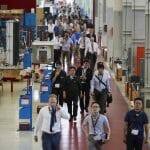In 2017, Google announced that it would cease production of its original Google Glass, replacing it with a new Enterprise Edition. Here Jonathan Wilkins, marketing director at obsolete industrial parts supplier, EU Automation explores the consumer technologies that have been welcomed into industrial environments.
Since its initial launch in 2013, the original Google Glass received a less than friendly welcome from consumers, claiming that it provoked an intrusion of privacy because of its ability to record people without their permission. However, rather than wasting the concept, Google reinvented the product, making it more appealing for use in business environments.
Like any disruptive technology with roots in the consumer market, industry viewed Google Glass with a certain level of scepticism to begin with. Many companies questioned the practical applications of the concept, labelling it another gimmick that would not stand up to the rugged manufacturing environment. However, Google Glass has proven successful amongst staff on the factory floor due to its ability to load instructions on-screen.
New concepts and technologies are prone to hype. In 2015, Gartner’s Hype Cycle saw VR emerging from the Trough of Disillusionment into the Slope of Enlightenment – this means VR started being used for real-world useful applications.
Indeed, a PWC survey at the beginning of 2016 found that more than a third of the US manufacturers surveyed, already used VR technology or planned to do so in the next three years.
Virtual design
The automotive market tends to be an early adopter of disruptive technologies — including automation, robotics and now VR.
The US automotive manufacturer Ford built its own immersion lab where designers, engineers and other employees can don an Oculus Rift headset and walk around exploring the exterior and interior of its cars.
Ford uses VR to test its designs and assess how individual elements of a vehicle look, without having to build a physical car. The VR links directly with the company’s computer aided design (CAD) software, so engineers can make changes and visualise results quickly and easily.
Some manufacturers have introduced a bring your own device (BYOD) policy to bring more technology into the factory. They encourage workers to bring phones, tablets and other smart devices to work to access corporate data and complete work.
As there are around 2.53 billion smartphone users worldwide — a number that is estimated to increase, it is not difficult for manufacturers to introduce more technology to the factory without excessive costs.
Workers understand their own technology better than new systems, so will be more productive as they will not struggle with unknown software or accounts. Using employee technology also reduces costs as manufacturers can what technology will be the best investment rather than struggle to keep up to date.
Adding these devices to the factory floor can vastly improve productivity and safety. However, introducing technology from different users can leave a factory vulnerable to cyber security breaches.
Just because a piece of technology is not widely accepted in the consumer market, it does not mean that it cannot be used for another purpose. Devices like Google Glass may not be the technology you turn to when you take a selfie, or send a text, but a manufacturer may rely on their features to keep their factory running.








